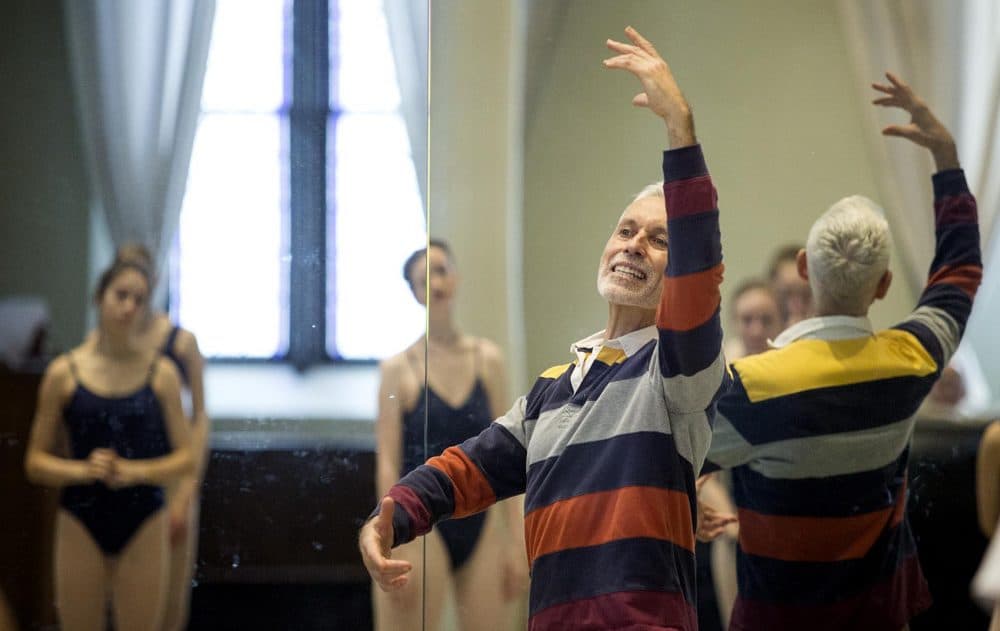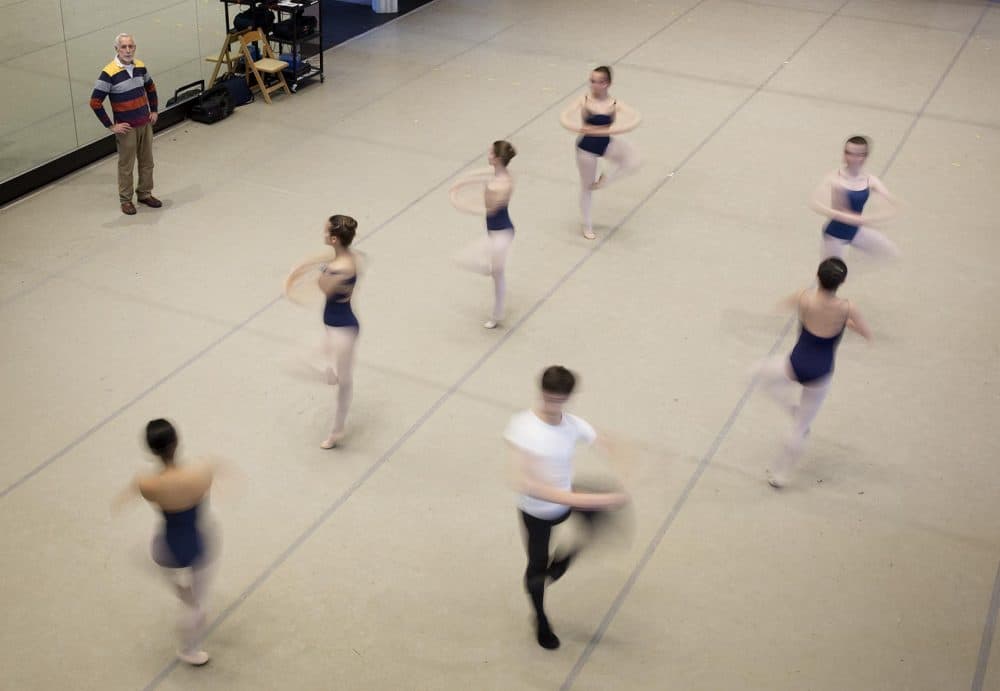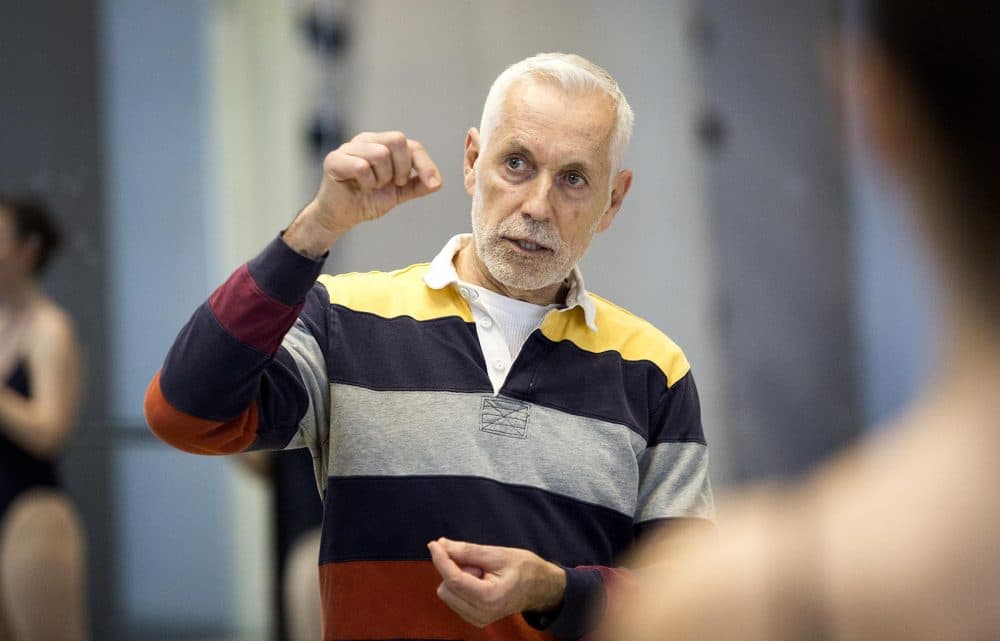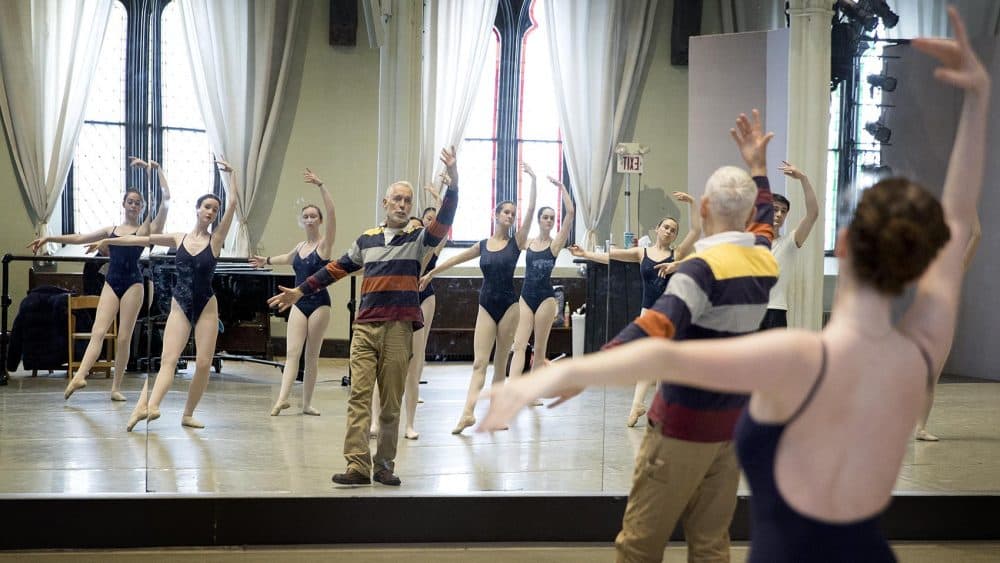Advertisement
After 32 Years Directing His Ballet Theatre, José Mateo Shifts Focus To Education And Outreach

Ten young dancers, ages 15 to 21, stand rapt along three ballet barres in the main studio of José Mateo Ballet Theatre’s school in the Old Cambridge Baptist Church. They’re watching Mateo, dressed in comfortable jeans and a grey knit shirt with elbow patches, demonstrate not the position but the essence of a cambré, or upper body arch.
“After you turn the head and hand, both things go like a blade of grass,” he says gently, his raised arm and sternum lifting toward the vaulted ceiling, his back arcing in response. “Like everything that comes from the soil, it’s a little bit more subtle as it goes up.
The lesson captures the aesthetics that drive Mateo’s choreography, the pedagogy that shapes his organization’s school, and the spirit behind Dance for World Community (DWC), a set of community programs he launched in 2008, that aims, he says, “to reposition the role of dance, in all its forms, in the Greater Boston area.”
To José Mateo, ballet is a life force — for everyone, regardless of body type, age, background or level of proficiency. It’s an artform, yes, but also so much more. He believes it improves lifelong physical and emotional health, sharpens critical-thinking skills, expands our understanding of cultures and nurtures collaboration and contributions to civic life.
Now Mateo, 66, wants to spread that philosophy further. His troupe is currently performing its last program under his direction, "Moving Violations." When the lights go down in the Sanctuary Theatre on April 29, Mateo, the company’s sole choreographer for 32 years, will retire as artistic director, temporarily putting the troupe’s repertory concerts on hold, save for the annual performance of its legendary "Nutcracker." The space will continue to be available to outside performing groups at affordable rates.
“In dreams begins responsibility,” Yeats wrote as an epigraph to his 1914 poem, “Responsibilities.” Mateo’s move turns the phrase into action: He will now focus on further developing his school, which has studios in Cambridge and Dorchester, and his community outreach initiatives — the projects that drive his vision of ballet as an inclusive, life-enhancing endeavor.
Those in the dance community say it marks a seismic shift in the Boston ecosystem.
Advertisement
“Ballet Theatre is the only major ballet company in Boston other than the Boston Ballet,” says Tony Williams, a former principal dancer with the Boston Ballet who has led the Tony Williams Dance Center, in Jamaica Plain, for 18 years and presented his own version of the seasonal tale, the "Urban Nutcracker," since 2001. “So there’s going to be a big hole in the dance community and the city, particularly for a chamber-size troupe.”

Looking Forward
José Mateo Ballet Theatre (JMBT) has come to this place prepared. The transition has been in the works for more than five years. In 2013, the board of directors, under the leadership of Rick Shea, began exploring how the organization could preserve Mateo’s legacy as an educator, choreographer and community builder, as well as pave the way for a smooth succession of leadership.
“An important part of the plan is to capture José’s pedagogy, his instructional technique and approach, which is different from that of most ballet schools associated with a professional company,” says Shea, who met Mateo in 1969 when they were both undergraduates at Princeton University taking a dance class taught by now renowned modern dancer/choreographer Ze’eva Cohen. Also crucial is to find a way to catalog Mateo’s choreographic works — a tall order, given the elusive nature of dance.
For Mateo, the shift brings sadness but also relief and opportunity. “My intention was always to start a different kind of model for a school, and a different kind of community outreach initiative,” says Mateo. “I feel as though I’ve never really been able to either complete, or solidify, either of those models.”
Now he can. With the jobs of choreographing and directing put aside, he will have more time and energy to expand and shape both DWC’s activities and the school’s educational offerings, particularly in Dorchester, which for the past two years has held classes in a studio at St. Mary’s Episcopal Church. According to JMBT spokesperson Julie Miller, Mateo plans to grow the Dorchester program to mirror the one in Cambridge by 2026, offering not just a Young Dancers’ Program, as it does now, but also classes for pre-professionals, teens and adults of all ages.
The selection of Dorchester, where the company first debuted at the Strand Theatre in 1987, came naturally. “Bringing ballet to new audiences has been a principal value of the school and the company from its inception,” says Mateo, as has programming for community outreach. “After 30 years you realize, 'OK, there are certain populations that are going to be harder to reach than others, be it for cultural reasons, for geographic reasons, for economic or class reasons.' ” Dorchester was one of them. So was Duxbury, a town that had no ballet until JMBT came there, and ran a program for 15 years.

DWC, for its part, has already brought the organization’s outreach to a new level. “It uses the power of dance to strengthen and build communities and support networks among dance organizations and other nonprofits and community organizations,” says Shea. In addition to yearlong efforts such as Sponsor a Child in the "Nutcracker" and the Community Ticket Access Program, DWC holds a free annual summer festival in Harvard Square that typically draws about 20,000 people, says Miller. This year’s festival — celebrating DWC’s 10th anniversary — will feature a smorgasbord of indoor and outdoor performances by some 90 diverse participants on five stages.
“Let’s show dance in all its forms, and all its formats, and all its styles,” says Mateo, describing the festival’s reason for being. “So that dances that once were not considered performance dances — they might have been traditional national dances, for example — can be brought to the stage and shared. Then we can begin to see the real breadth of dance, and the way different forms have for so long engaged so many populations. Let’s provide the spaces, the environment, where education can happen in a different way than it has.”
Mateo’s unique role in the Boston dance community has not gone unnoticed. “When Boston Dance Alliance named José our Dr. Michael Shannon Dance Champion in 2012, it was a public recognition of his ongoing work as a company director and teacher,” says Debra Cash, executive director of Boston Dance Alliance, a nonprofit that supports local dance organizations. “I think Boston dance will look back at his legacy as an institution builder. With [managing director] Scott Fraser, José has been able to preserve and transform the space that became JMBT’s Sanctuary Theatre, envision the inclusive community-building activities of Dance for World Community and the work going forward of bringing generations of young people to dance.”
A Different Kind Of Model
Mateo’s description of the impetus behind DWC is a far cry from the elitist attitude that characterizes much of the ballet world.
His model for the school follows suit. It calls for the technique, athleticism and musicality of classicism, but not of the one-size-fits-all sort that most American ballet schools have adopted from the European and Russian academies. The emphasis is on the “breadth, the range of expression, that is possible through this artform,” says Mateo. “That includes the diversity of human relationships that people can convey through movement, and that audiences can relate to. I’m focused a lot on the power of music as a conveyor of environments and worlds that are inhabited by human beings of different stripes and inclinations.”
Accomplishing that requires personalized teaching and encouraging the development of the whole person. That means asking, “What can your body do, in ballet?” he says. “What are your hips, your shoulders doing? How are you holding that head up? What is your spine subjecting itself to? And to begin to understand the person’s body, and begin to help them understand how they can take that very unique body, and apply it to learning the language of ballet.”

Patricia Chiang, 25, who has been with Mateo for 14 years, first in the Young Dancers’ Program and now as a company member and teacher of children in the school, attests to the value of that humanistic approach. “José always instilled in me the value of achievement — but achievement across the board,” says Chiang. “The fact that every student, no matter what their background, their body, their economic status, that every student deserves equal access to the same ballet education, which is not available to most people for financial or physical reasons.
"As a teacher, I have a very wide range of kids, and you never know what dance can mean to them. If you’re only looking at, ‘I want to produce the best dancers,’ or, ‘Who has the most flexible body?’ you miss a lot. The power of dance and the feeling it can give kids is something that I think is underutilized especially in ballet because ballet historically has been so selective.”
Unlike Chiang, Anita Walker, executive director of the Massachusetts Cultural Council, is not a dancer. But she, like so many others, has experienced the magic of Mateo’s method.
“To José, we’re all dancers,” she says. One of the first times she met him was on a site visit with her colleagues — the council does site visits to all the organizations it funds with operating support. “I’ll never forget when we first visited him in the studio in Cambridge at the church. Before I knew it, he had all of us at the barre doing pliés. It was such an amazing experience to do something that you only thought was for special people. We could dance. We were all special. That was a gift he gave all of us.”
José Mateo Ballet Theatre performs "Moving Violations," a program of four pieces, including the premiere of “New Pasts,” through April 29 at the Sanctuary Theatre in the Old Cambridge Baptist Church.